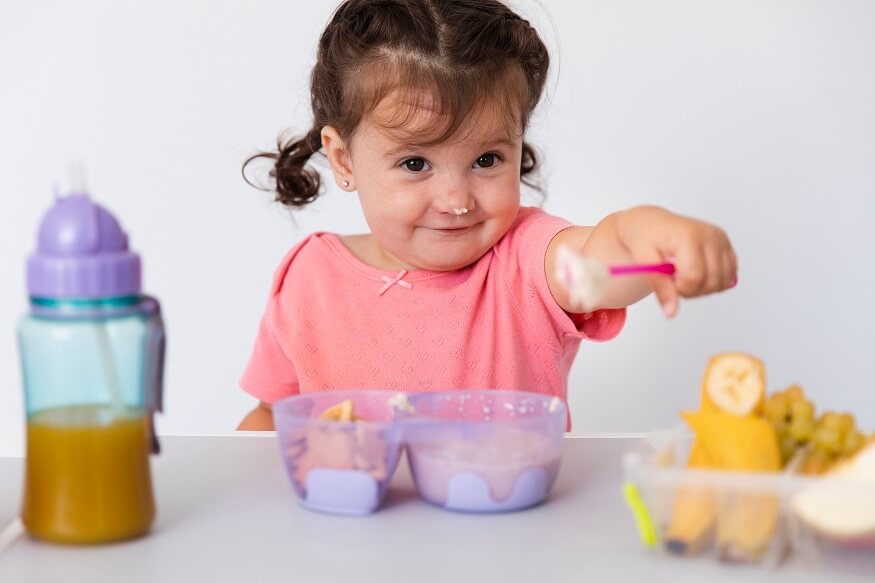Baby-led weaning (BLW) is an increasingly popular approach to introducing solid foods to infants. Rooted in the belief that babies can take charge of their own feeding experiences, BLW encourages self-feeding from the very start. In this article by EuroSchool, we will delve into the fundamentals of Baby-Led Weaning, providing valuable insights on how to get started, along with a comprehensive list of foods to feed and avoid.
Getting Started with Baby-Led Weaning
Readiness Signs
Before embarking on the BLW journey, it’s crucial to ensure your baby is developmentally ready. Look for signs such as good head control, the ability to sit up unaided, and an interest in reaching for food. Typically, babies are ready for BLW around six months when their digestive system has matured sufficiently.
Offering Safe Foods
When introducing solids via BLW, safety is paramount. Foods should be cut into manageable pieces to prevent choking hazards. Opt for soft textures initially, gradually progressing to more challenging consistencies. Common BLW-friendly first foods include strips of cooked vegetables, ripe fruits, and well-cooked meat.
Serving Size and Consistency
Present foods in sizes and shapes easy for your baby to grasp. Finger-sized portions or small, manageable chunks work well. Cooked vegetables, soft fruits, and well-cooked pasta or rice are excellent starting points. Ensuring a manageable consistency is vital to promote successful self-feeding without overwhelming your little one.
Mealtime Environment
Create a conducive environment for mealtime exploration. Sit your baby in an upright position, preferably in a high chair. Minimise distractions to encourage focus on the eating experience. Allow your baby to handle the food, promoting sensory exploration, even if it results in messy mealtimes.
Patience and Observation
Baby-led weaning is a gradual process. Patience is key as your baby learns to navigate the world of solid foods. Observe their cues and reactions to different textures and flavours. Respect their preferences and pace, letting them take the led in their feeding journey.
Also Read: How do I Get My Toddler To Chew Food? Try These Simple Methods
Foods to Introduce with Baby-Led Weaning
Here’s a comprehensive list of foods to introduce with Baby-Led Weaning:
Soft Vegetables
- Steamed or roasted carrot sticks
- Broccoli florets
- Avocado slices
- Sweet potato wedges
Fruits
- Soft ripe banana
- Slices of ripe peach or pear
- Melon cubes
- Blueberries (ensure they are cut in halves or quarters)
Proteins
- Well-cooked chicken strips
- Shredded cooked fish
- Soft tofu cubes
- Scrambled eggs
Carbohydrates
- Cooked pasta spirals
- Rice cakes
- Toast fingers
- Oat-based porridge fingers
Dairy
- Cubes of mild cheese
- Full-fat yoghurt in small spoonable portions
Textures to Explore
Introduce a variety of textures, from soft to slightly lumpy, to help develop your baby’s oral motor skills.
- Mashed potatoes with a smooth texture
- Hummus for dipping soft vegetable sticks
- Greek yoghurt with a spoonable consistency
Blended Foods
- Pureed fruits like apples, pears, or bananas
- Smooth vegetable purees, such as sweet potato or butternut squash
- Nut and seed butter (if no allergies are present, and they are spread thinly on soft bread or toast)
Soft Bread and Grains
- Soft bread strips or toast fingers
- Cooked quinoa or couscous
- Porridge oats cooked to a soft consistency
Homemade Patties and Balls
- Soft vegetable patties (e.g., sweet potato and pea patties)
- Quinoa or rice balls with finely chopped vegetables
Cooked Legumes
- Soft cooked lentils
- Mashed or lightly smashed beans (e.g., chickpeas or black beans)
Meat and Alternatives
- Ground meat cooked in small, well-cooked portions
- Soft-cooked and finely shredded beef or poultry
- Alternatives like tempeh or tofu cut into manageable pieces
Soft Cheese
Mild cheese varieties cut into small cubes or strips
Finger-Friendly Snacks
- Rice crackers
- Corn puffs (with minimal salt and sugar)
- Mini rice cakes
Drinks
Water in an open cup or a free-flow sippy cup
Exploratory Foods
Foods with interesting textures for exploration, such as pomegranate seeds or kiwi chunks (ensure they are cut into baby-friendly sizes).
Also Read: Educating Children To Minimise Food Waste: Tips And Importance
Foods to Avoid in the Early Stages
Here’s a list of foods to avoid during the initial phases of BLW:
Choking Hazards
- Whole grapes: Cut them into halves or quarters to reduce the risk of choking.
- Cherry tomatoes: Cut into small pieces to avoid choking hazards.
- Large chunks of meat: Opt for finely shredded or minced meat to make it easier for your baby to handle.
Hard or Crunchy Foods
- Raw vegetables like raw carrots: Cook or steam them to soften.
- Popcorn: Its hard texture poses a choking hazard.
- Nuts and seeds: These can be a choking risk and may also cause allergies.
Processed Foods
- Minimise the introduction of processed and packaged foods, especially those high in salt, sugar, and artificial additives.
- Avoid fast food items, chips, and other heavily processed snacks.
Highly Allergenic Foods
Hold off on introducing potentially allergenic foods until later stages of weaning (around 6-12 months). These may include:
- Nuts and seeds
- Shellfish
- Eggs (unless they have been advised by a healthcare professional)
- Honey: Avoid giving honey to infants under one year of age due to the risk of infant botulism.
- Cow’s Milk (as a Main Drink): It’s recommended to wait until around 12 months before introducing cow’s milk as a primary drink. Before that age, breast milk or formula should remain the main source of nutrition.
- Excessive Salt and Sugar: Limit the use of salt in cooking for your baby. High salt intake is not recommended for infants.
- Avoid sugary foods and drinks as they contribute to dental issues and can impact healthy eating habits later in life.
Unsuitable Textures
- Foods with tough textures that may be difficult for your baby to handle initially.
- Foods with small, hard seeds (e.g., strawberries) that can pose a choking hazard.
Large Fish with High Mercury Content
Avoid large fish with high mercury levels, such as sharks, swordfish, king mackerel, and tilefish. Opt for low-mercury fish options like salmon or trout in moderation.
Spicy Foods
Introduce mild flavours initially. Spicy foods may not be well-tolerated by your baby’s developing palate.
Also Read: Understanding Constipation In Children And Foods To Avoid
Every baby is unique, so embrace the individuality of your child’s feeding journey and enjoy the messy, joyful process of discovering new tastes and textures together. For more such informative articles, read EuroSchool blogs.










